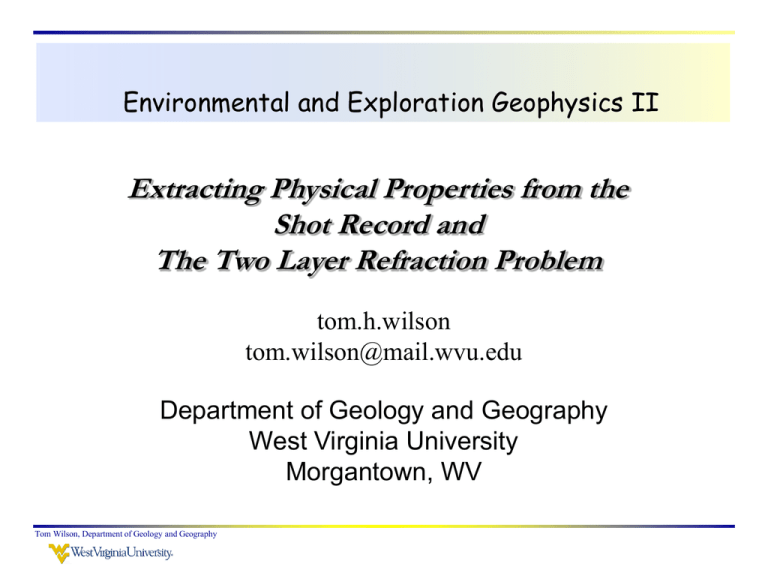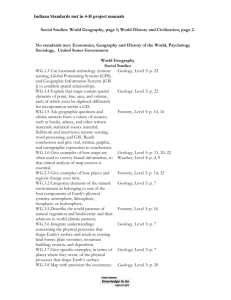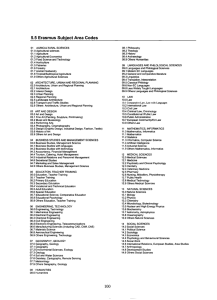In ray-trace exercises I-III
advertisement

Environmental and Exploration Geophysics II Extracting Physical Properties from the Shot Record and The Two Layer Refraction Problem tom.h.wilson tom.wilson@mail.wvu.edu Department of Geology and Geography West Virginia University Morgantown, WV Tom Wilson, Department of Geology and Geography Tom Wilson, Department of Geology and Geography Tom Wilson, Department of Geology and Geography 1) label all plotted curves, 2) label all relevant points and 3) Note (comment on) basic relationships between events observed in the time-distance plots (see following) Tom Wilson, Department of Geology and Geography •Do Exercise II and III using Excel. •In exercise II comment on the origins of the differences in the two reflection hyperbola? What is their relationship to corresponding direct arrivals. Tom Wilson, Department of Geology and Geography For Exercise III, explain the differences observed in the arrival times of the reflection and diffraction observed in the shot record. Why does the diffraction event drop below the reflection? Tom Wilson, Department of Geology and Geography For the Barrel Interpreter The following references will be provided on a sign out basis Brown AAPG Memoir 42, 1986 3D Interp Brown, 2004, more recent volume on 3D interp (6th ed) Neidel, 1979, strat modeling Yilmaz, 2001, seismic data analysis, volumes 1 and 2 Lines and Newrick, 2004, fundamentals of seismic interp. Biondi, 2007, Concepts and apps in 3D imaging … We can be more focused once we know where the project You will first want to research the AAPG area is … bulletin and Journal Geophysics for For now the basics … publications related to the project area Tom Wilson, Department of Geology and Geography SOFAR Channel – sound fixing and ranging channel Tom Wilson, Department of Geology and Geography Absorption When we set a spring in motion, the spring oscillations gradually diminish over time. In the same manner, we expect that as a seismic wave propagates through the subsurface, energy will be consumed through the process of friction and there will be conversion of mechanical energy to heat energy. We guess the following - there will be a certain loss of amplitude dA as the wave travels a distance dr and that loss will be proportional to the initial amplitude A. i.e. dA AS dr Tom Wilson, Department of Geology and Geography dA(r ) AS dr dA(r ) dr AS is a constant referred to as the attenuation factor In order to solve for A as a function of distance traveled (r) we will have to integrate this expression In the following discussion,let A0 AS A dA r A0 A 0dr ln A ln A0 r Tom Wilson, Department of Geology and Geography ln A ln A0 r A ln r A0 ln e A A0 er A er A0 A A0er Tom Wilson, Department of Geology and Geography Mathematical Relationship A(r ) A0er Graphical Representation Tom Wilson, Department of Geology and Geography The physical significance of A(r ) A0er - the attenuation factor is also a function of additional terms is wavelength, and Q is the absorption constant Q 1/Q is the amount of energy dissipated in one wavelength () - that is the amount of mechanical energy lost to friction or heat. Tom Wilson, Department of Geology and Geography Q is also a function of interval velocity, period and frequency Tom Wilson, Department of Geology and Geography r A(r ) A0e Q A(r ) A0e QV r is just the reciprocal of the frequency so we can also write this relationship as f A(r ) A0e QV Tom Wilson, Department of Geology and Geography r Smaller Q translates into higher energy loss or amplitude decay. Tom Wilson, Department of Geology and Geography A(r ) A0e f QV r increase f and decrease A Qf x A dB 20 log 20 log e A0 Higher frequencies are attenuated to a much greater degree than are lower frequencies. Tom Wilson, Department of Geology and Geography When we combine divergence and absorption we get the following amplitude decay relationship A0 r A(r ) e r The combined effect is rapid amplitude decay as the seismic wavefront propagates into the surrounding medium. We begin to appreciate the requirement for high source amplitude and good source-ground coupling to successfully image distant reflective intervals. Tom Wilson, Department of Geology and Geography But we are not through - energy continues to be dissipated through partitioning - i.e. only some of the energy (or amplitude) incident on a reflecting surface will be reflected back to the surface, the rest of it continues downward is search of other reflectors. The fraction of the incident amplitude of the seismic waves that is reflected back to the surface from any given interface is defined by the reflection coefficient (R) across the boundary between layers of differing velocity and density. Z 2 Z1 R Ainc Z1 Z 2 Arefl Tom Wilson, Department of Geology and Geography Z 2 Z1 R Ainc Z1 Z 2 Arefl Z1 and Z2 are the impedances of the bounding layers. 2V2 1V1 1V1 2V2 Tom Wilson, Department of Geology and Geography Z 2 Z1 R Z1 Z 2 The transmitted wave amplitude T is T 1 R Z1 Z 2 Z 2 Z1 T Z1 Z 2 Z1 Z 2 2 Z1 T Z1 Z 2 Tom Wilson, Department of Geology and Geography At a distance of 100 m from a source, the amplitude of a P-wave is 0.1000 mm, and at a distance of 150 m the amplitude diminishes to 0.0665 mm. What is the absorption coefficient of the rock through which the wave is traveling? (From Robinson and Coruh, 1988) Tom Wilson, Department of Geology and Geography Set up the equation that needs to be solved in the foregoing problem. Write it down on a piece of paper and hand in. Write down the Excel equation you would use to solve for the diffraction time-distance relationship as portrayed in ray trace exercise II Tom Wilson, Department of Geology and Geography The critical distance and the crossover distance. xcrit 2h1 tan c To determine the crossover distance set the direct arrival time equal to the critical refraction arrival time and solve for Xcross Tom Wilson, Department of Geology and Geography This is a new one, but pretty simple – see 3.2.4 xcross Tom Wilson, Department of Geology and Geography V2 V1 2h1 V2 V1 We now have several equations which contain quantities that we can measure directly from the shot record and use to determine layer thickness - h1. h1 ? Tom Wilson, Department of Geology and Geography • Reflection time intercept • Refraction time-intercept • Crossover distance • Critical Distance Tom Wilson, Department of Geology and Geography The two-layer refraction problem (see 3.3.1) Tom Wilson, Department of Geology and Geography Time =distance traveled/velocity Tom Wilson, Department of Geology and Geography For the details see 3.3.1 Tom Wilson, Department of Geology and Geography Tom Wilson, Department of Geology and Geography Tom Wilson, Department of Geology and Geography Tom Wilson, Department of Geology and Geography Tom Wilson, Department of Geology and Geography Snell’s law for multiple layers sin 1 sin 2 1 V1 V2 V3 C Tom Wilson, Department of Geology and Geography The velocity triangle Tom Wilson, Department of Geology and Geography Expressing trig functions in terms of velocities Tom Wilson, Department of Geology and Geography V32 V12 The end result, where cos 1 V3 and … x 2h1 cos 1 2h2 cos c time= V3 V1 V2 2h2 x 2h1 2 2 time= V3 V1 V32 V22 V3 V3V1 V3V2 dx 1 dt V3 Tom Wilson, Department of Geology and Geography • What is the critical distance • What is the relationship of the reflection from the base of layer 2 to the critical refraction from the top of layer 2 Tom Wilson, Department of Geology and Geography As x gets larger and larger the reflection from the base of layer 2 and the refraction across the top converge Tom Wilson, Department of Geology and Geography Tom Wilson, Department of Geology and Geography In the three layer problem the number of possible terms that could potentially be measured directly from the shot record includes - •V1, V2 and V3 •two reflection time intercepts •two refraction time intercepts •one crossover distance, and •two critical distances Tom Wilson, Department of Geology and Geography How would you determine the thickness of layer 2 (h2)? • From reflection arrivals • From refraction events? Tom Wilson, Department of Geology and Geography What variables can be determined from an analysis of the shot record V1, V2, V3, ti1, & ti2, where the ti’s refer to the reflection time intercepts V2 ti 2 ti1 V1ti1 h1 & h2 2 2 Tom Wilson, Department of Geology and Geography What variables can be determined from an analysis of the shot record V1, V2, V3, ti1, & ti2, where the ti’s refer to the refraction time intercepts h1 V1V2 2 V22 V12 ti1 & 2h1 2 2 h2 t V3 V1 2 2 i2 V3V1 2 V3 V2 V3V2 Tom Wilson, Department of Geology and Geography 1) We have assumed that our layers have successively higher and higher velocity. What happens if we have a velocity inversion let’s say V2 is less than V1 and V3? 2) Another assumption we have made here is that the refraction from the top of the third layer, for example, will actually show itself, and not get buried somewhere beneath the earlier refraction and reflections. This can happen if the 2nd layer is too thin. Tom Wilson, Department of Geology and Geography Today turn in problem 2.6, 2.7 and 2.12 Please read through Chapter 3, pages 95 to top of 114. Chapter 4, pages 149 to 164 (as assigned previously. • Continue working Exercises I-III and bring questions to class next Monday (due next Wednesday) • Also consider the attenuation problem and be prepared to discuss further on Monday (due next Wednesday). Tom Wilson, Department of Geology and Geography



